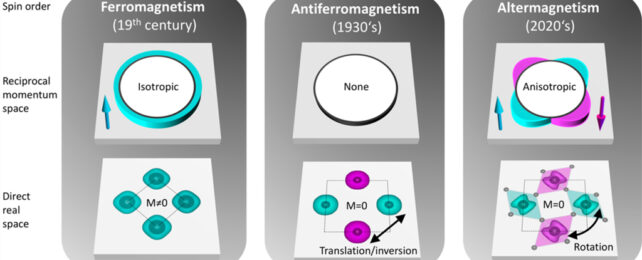ARTICLE AD
 Ferromagnetism now comes in three varieties. (Libor Šmejkal)
Ferromagnetism now comes in three varieties. (Libor Šmejkal)
There was a time when there was only one game of ferromagnetism in town. Want to know your north from south? Hold up a compass. Want to stick your electricity bill to the fridge? Bang on a tiny magnetized Garfield gulping down lasagna.
Of course, science had to come and complicate matters by finding a second class of ferromagnetic activity.
Theorized and experimentally demonstrated in the 1930s, antiferromagnetism is like the evil nemesis of the fridge magnet, displaying a similarly stable sub-atomic alignment with a twist that cancels out its stickiness and turns Garfield into the world's most annoying paper weight.
As confirmed in experiments conducted by a team of researchers from across Europe and in the UK, there's now yet another type of magnetism that sits in between the two, described as altermagnetism.
"Altermagnetism is actually not something hugely complicated," says the study's principal investigator Tomáš Jungwirth, a physicist from the Czech Academy of Sciences.
"It is something entirely fundamental that was in front of our eyes for decades without noticing it."
Predicted just a few years ago by Jungwirth and some of his fellow researchers, altermagnetism describes alternating energy bands of ferromagnetism and antiferromagnetism that cancel out overall, while still retaining permanent magnetic features on a small, local level.
Granted, an 'altermagnet' won't stick your bills where you won't forget, either, but we might want to give this new member of the ferromagnetic family a chance – it could be just the thing future electronics needs.
Critical to each of these three magnetic manifestations is a characteristic of quantum objects called spin. Like the rotation of a tiny ball, spin describes a kind of angular momentum, one that exerts a tiny force like an itty-bitty magnet. Unlike the rotation of a tiny ball, spin is never fast or slow. Just one direction or the other. Or to use the proper jargon, up or down.
Individual electrons can feature either of the two spin directions, yet in most materials the assortment of up and down spins are jumbled with no real consensus on a total sense of direction.
In ferromagnetic materials, like iron, electron spins can be forced into alignment by an external field, remaining that way even once the external field has been deactivated. This turns a gazillion tiny, atomic-sized magnetic tugs into something strong enough to pick up a chain of paper clips.
The diverse relationships between spin arrangement and magnetic activity on a macroscopic scale has only grown more complex over time. Recently, the introduction of a quantity of electrons into atomically-thin layers of stacked semiconductors created a 'kinetic' version of ferromagnetism, for example.
Yet until now, stable arrangements of spins in materials were thought to be either collectively ferromagnetic, or paired in a way to cancel out antiferromagnetically.
Altermagnets are thought to have similar electron pairings as antiferromagnets that connect in such a way that preserves rather than negates their contrasting magnetic moments.
To find physical signs of this particular arrangement, Jungwirth and his team made use of a laboratory technique to identify a signature splitting of X-rays from a synchrotron passing through a crystal lattice of a compound made from manganese and tellurium.
"Thanks to the high precision and sensitivity of our measurements, we could detect the characteristic alternating splitting of the energy levels corresponding to opposite spin states and thus demonstrate that manganese telluride is neither a conventional antiferromagnet nor a conventional ferromagnet but belongs to the new altermagnetic branch of magnetic materials," says physicist Juraj Krempasky from the Paul Scherrer Institute.
Finding evidence of this novel class of ferromagnetic material not only builds on theories of materials physics, it could contribute to the development of an emerging technology of electronics based not just on the particle's charge, but its spin as well.
This research was published in Nature.

 1 year ago
91
1 year ago
91 

